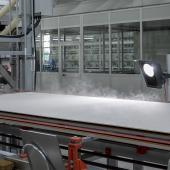Poland, building activity down by 7.1%
According to figures provided by Gus (the Polish national statistical institute), the final figures for the Polish building sector in 2002 show a fall. Production has dropped by 7.1% on an annual basis. The sectors most seriously affected are new residential building with a further 25% fall in building permits compared to 2001 to reach 192,500: a considerable drop compared to the peak of 315,600 permits in 1998. The situation is particularly critical considering that the approximately 90,000 dwellings consigned in the whole of 2002 fall far short of the housing requirements estimated by the government of three million residential units by 2020.
Nonetheless, the forecasts for the future are positive. According to Euroconstruct, the building sector is expected to expand by 3% this year and then accelerate to 7.5% in 2004 (the year when Poland will be joining the European Union). Residential building is likely to remain weak (with a further fall of 2.9% this year followed by growth of just 3.2% next year), while public works will remain the only motor of development (17% up in 2003 and 15.3% in 1994). There are two factors that may help to bring residential building back to levels more in keeping with a country that still has a large housing deficit.
The first cause for optimism concerns the outcome of the final negotiations for EU membership. The Polish government has been authorised to extend VAT concession (rate of 7%) on building and sale of new houses until 2007. Another factor is a recent measure for simplifying legislation that makes it easier to obtain a building permit at the beginning of the process and a certificate of habitability at the end. This will ensure that users - particularly those who make purchases through cooperatives - will not lose out on tax benefits that last for just three years between receiving the authorisation and finalisation of the purchase.
In focus section: 2002 performance sector by sector
The most severely hit sector of Polish building is that of single-family houses, where the number of permits has fallen by half over the past year. The office and hotel building sectors have also experienced a fall, albeit to a smaller extent. Industrial and commercial building has escaped this negative trend due to the continued interest of foreign investors, who have been financing new out-of-town shopping centres since 1995. In this latter segment, until 2004 Poland should be able to count on an influx of European investments allowing for the construction of 1.7 million square metres.
The only sector that continues to hold strong is that of public works, buoyed by the continued injection of international funding (the European Investment Bank alone invested more than a billion euro in Poland in 2002, almost two-thirds of which was for improving transport infrastructures).
Did you find this article useful?
Join the CWW community to receive the most important news from the global ceramic industry every two weeks
Recent articles
Gruppo B&T at Ceramics China 2025
Jun 30, 2025
Cersaie 2025 already booked out
Jun 27, 2025
GMM USA installs IMAnalytics system in the USA
Jun 26, 2025





















